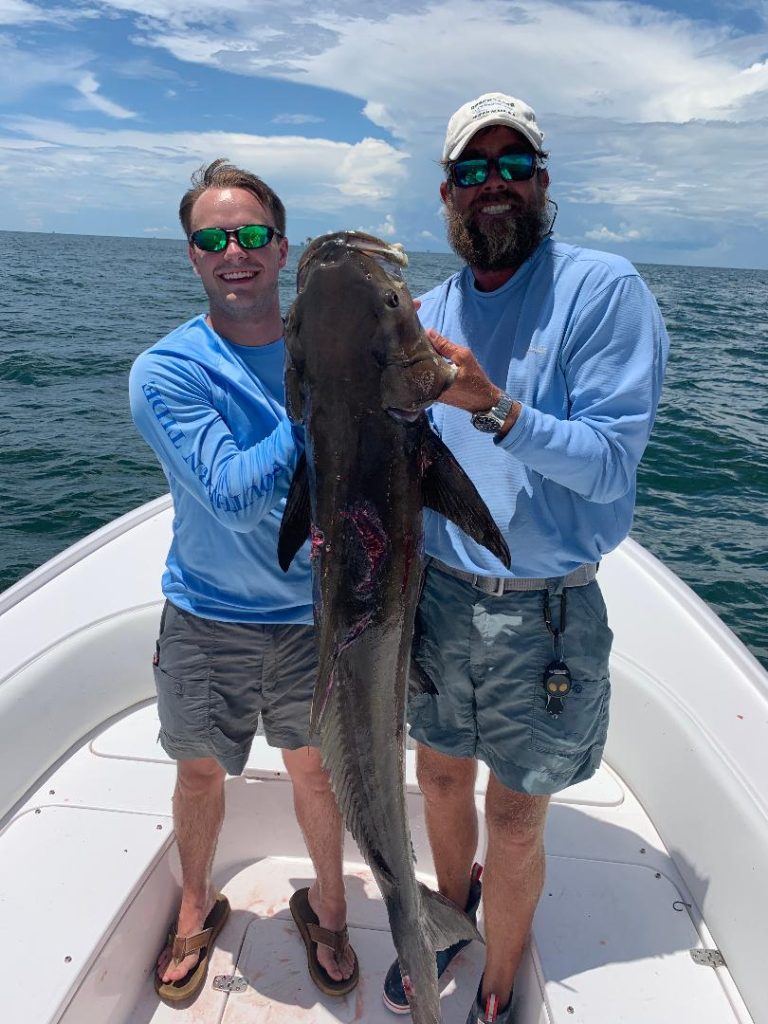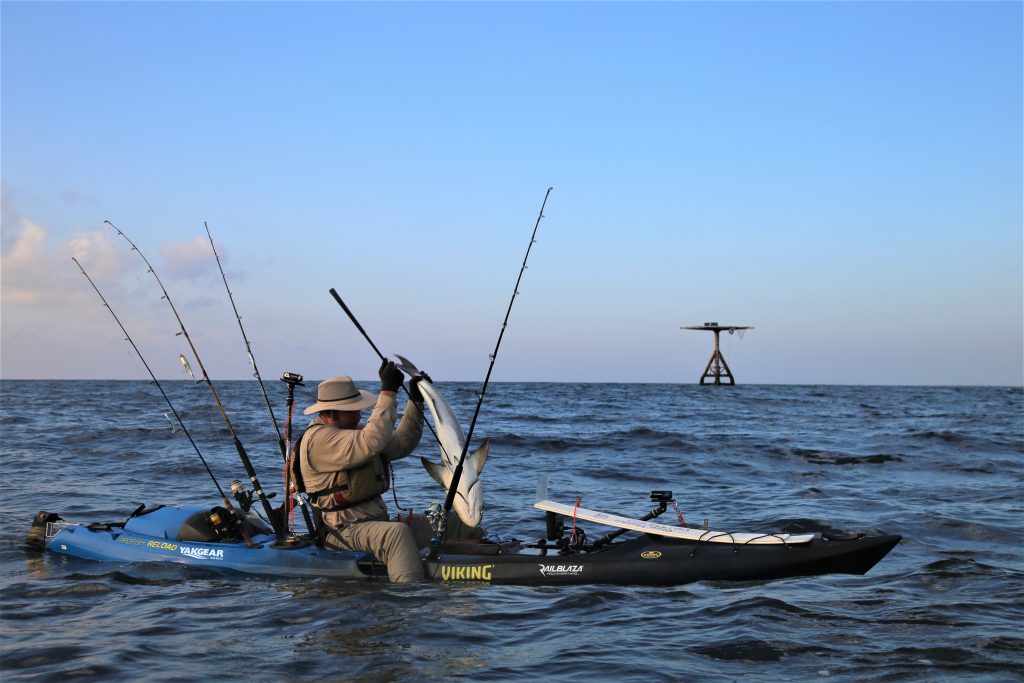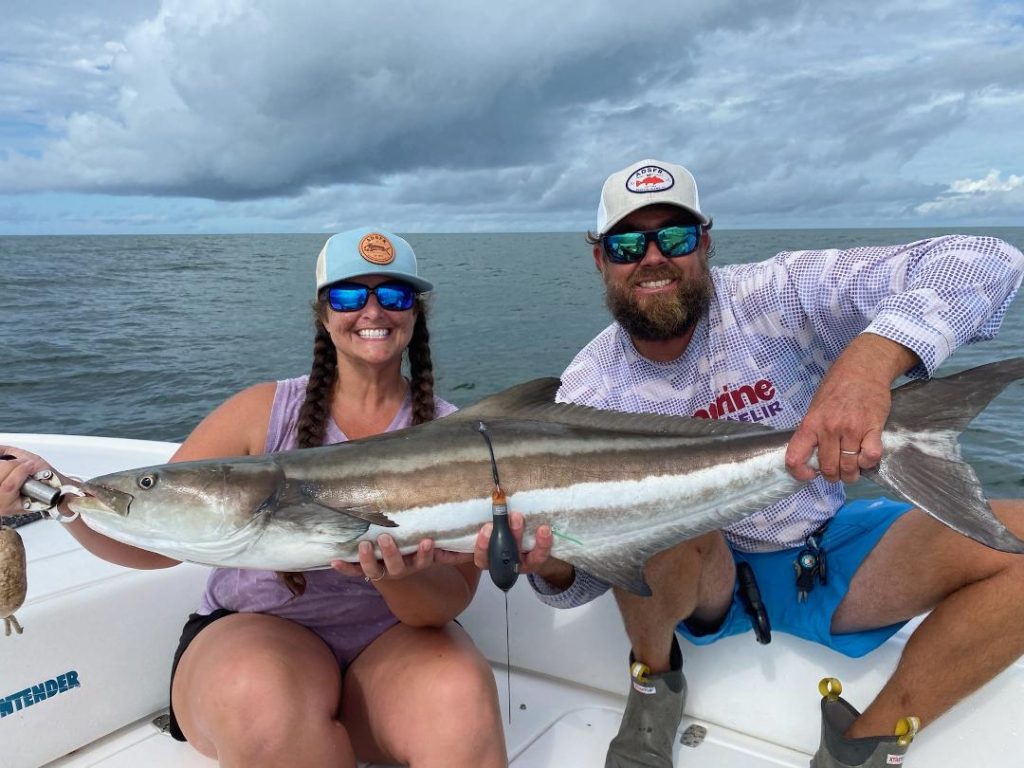Cobia Fishing Tips – Timing and Techniques
It’s that time of year again. The birds are migrating back from their winter spots, baseball season has started, and here on the Gulf Coast, it is that time of year when boats line up and cruise slowly along the beaches and bay passes looking for a very special returning favorite fish. That’s right, it’s cobia fishing time.
The problem with cobia time is that even though there are lots of cobia moving through our waters and these fish are usually quite eager to bite anything put before them, there’s a lot of water for the cobia to lose themselves in, and there are lots of anglers competing for these hard-pulling, delicious fish.
So any advantages an angler who wants to meet up with these big brown brawlers can find are very good things. And that’s what we’re going to do here- look at some advantages that a local cobia expert can give us.
Tip number one, before we get into specific gear and techniques, is a matter of timing.
“Cobia don’t follow the calendar. They generally arrive here in our waters around the first part of April. When the water starts to get to 66 to 68 degrees, the cobia start moving through. Anglers need to keep an eye on water conditions to find springtime cobia,” says Captain Richard Rutland, from Cold Blooded Fishing in Mobile.
Live Bait- a Good Start
For cobia as most gamefish, live bait works to entice them to eat when nothing else will. A good first step when fishing for cobia is to have some good live bait ready to go.
Traditionally, live eels are a prime cobia bait, but these things are hard to find in bait shops, and when found, they tend to be very costly. So, are there other live bait options?
“Usually I use live pogies or pinfish or croakers. Eels are too hard to get, and I can catch those other live baits myself, so I don’t have to pay for live bait,” Rutland said.

Cobia are strong fish and they migrate long distances to reach their spawning grounds.
“I free-line my live bait to cobia I see. I use a 40 to 60 pound main line, the same weight in fluorocarbon leader, and a 6/0 circle or J hook,” Rutland said. “If it’s later in the season, I’ll knocker rig live bait with a two or four ounce sinker around anchored ships and gas rigs.”
Chumming? When live baiting for cobia, Rutland doesn’t often chum for them, but when he does, it can work.
“I rarely chum. But if I’m around a platform and marking cobia on the fish finder I will. If they won’t bite, I’ll set up on the up current side of the rig and drift chum down to them. I like pogies for chum,” he noted.
Traditional Cobia Jigs
Throwing long-distance jigs for cobia spotted cruising through the clear springtime water of the Gulf Coast is a tried and true method for catching cobia.
“I like six to eight inch curly tail jigs. If I’m fishing deep for cobia, I’ll use a heavy six to eight ounce jig head,” Rutland explained. “Hogie Eels on jig heads are great if I can see the cobia, and I like chartreuse colors for the eel.”
Best Cobia Rigging- Get it Right
Going cobia fishing without the proper set up is a recipe for disaster. Cobia are powerful fish, and the wrong rig will not succeed in bringing one of these big brown brawlers to the boat or pier. It’s not uncommon to encounter seventy pound cobia, and every year, there will be 80 to 100 pound cobia caught in our Gulf Coast waters.
“I like a seven to seven and a half foot long spinning rod in the 20 to 40 pound line class. A 5000 to 6000 series reel is needed. I’ve been using Penn Clash reels, and they work well,” Rutland said.

Every year some truly big cobia are caught in our Gulf waters.
Rutland prefers 40 to 60 lb. braid main line with an eight foot long, 40 to 60 lb., fluorocarbon leader for both live bait fishing and also throwing jigs or other artificial cobia lures.
For those who prefer rigs other than spinning rods, Rutland supplies level wind reels.
“I will use a level wind reel and set up. I like the Shimano Tranx reel in the 400 series. You can cast or drop fish with this rig,” he explained.
Where to Look in Spring- They Could be Anywhere
The first and probably most important part of any cobia fishing trip is to actually find the fish. Cobia in springtime will move from east to west as they traverse our Gulf Coast waters, but they may be close to the beach or they may be a long way offshore.
“If I’m sight fishing, I’ll start out in 30 to 40 feet of water. Then I’ll zig-zag in this shallow water. The migrating cobia will usually be out past the second bar off the beaches, but sometimes they’ll be inside that bar. I’ve seen it both ways,” Rutland said.
Cobia chasers will need to have plenty of fuel aboard, because this “bar-hopping” method of spring cobia fishing can require many miles of slow-cruising along the bar watching the clear water for the long dark shapes of cobia to appear in the clear, green water.

Kayak anglers are often able to find and catch cobia when they migrate through our waters.
A lot of big cobia tend to orient around the many gas rig platforms and anchored ships out in the waters leading into Mobile Bay. These fish can be in large schools, and they tend to be hungry.
“When I’m fishing, I want to scan the surface first for any fish I see and cast to them. Then I look around the structure with electronics and side imaging really helps do this. I’ve found when I fish anchored ships, the cobia will either be holding up front on the anchor chain or they’ll be on the rear near the screws,” he explained.
And as his best advice to cobia chasers, Rutland says to always be ready.
“Always be ready. When I start a cobia fishing trip, I am rigged and ready. I’ll have a live bait hooked up and ready in the live well. If you see a fish and start rigging then, you are too late. You’ve got to be ready. And then when you see a cobia, don’t throw it right at it. Bait doesn’t fall out of the sky. Throw way past the fish and in front. Retrieve the bait to the fish,” he noted. “I try to throw 20 feet ahead and 20 feet past. And it’s good to have a second angler rigged and ready to throw if the cobia refuses the first offering. And remember most of the time, you won’t be throwing to a single fish. These migrating cobia tend to run in small packs of fish.”
As a special word of advice to springtime cobia chasers, Rutland advised, “And when I’m cobia fishing, I always have some live shrimp on board because at this time of year, you’ll see tripletail coming in, too. This can be a great by-catch. Tripletail love live shrimp.”
Getting Good Information About The Fishery
Recent detailed scientific studies are starting to shed some light on the previously unknown habits of these big brown fish.
Coastal Conservation Association of Alabama along with researchers from the University of South Alabama have embarked on a study to help determine where cobia go when they make their annual migrations.
CCA Alabama successfully deployed four Wildlife Computers mini-PSAT tags last year with the help of Rutland. These tags are pop-up satellite archival tags that record information about speed of travel, depth, temperature and light for the cobia which do not always stay near the surface.

Researchers are using tagged cobia to help determine their range and migration patterns.
The initial study indicated that some of the tagged fish moved in a south to southeast direction which is interesting because the fall migration generally is an eastward direction. These tagged fish may have eventually moved eastward or they may have moved into overwintering water south of the Alabama coast. Further tagging studies are planned to help learn more about this crucial cobia movement.
“Cobia are amazing fish, and their great ability to migrate coupled with the very rapid growth make them a wonderful but challenging species to study. With the assistance of CCA Alabama, we will be able to tag fish with tags that will give us information on the migration and discard (release after catch) mortality,” says Dr. Sean Powers, chairman of the University of South Alabama Marine Sciences department.
Contact Information
Captain Richard Rutland
251-459-5077
richard@coldbloodedfishing.com
Alabama Coastal Conservation Association
251-478-3474
info@ccaalabama.org
Full Disclosure: This post may include affiliate links. There’s no extra charge to our readers for using these.
